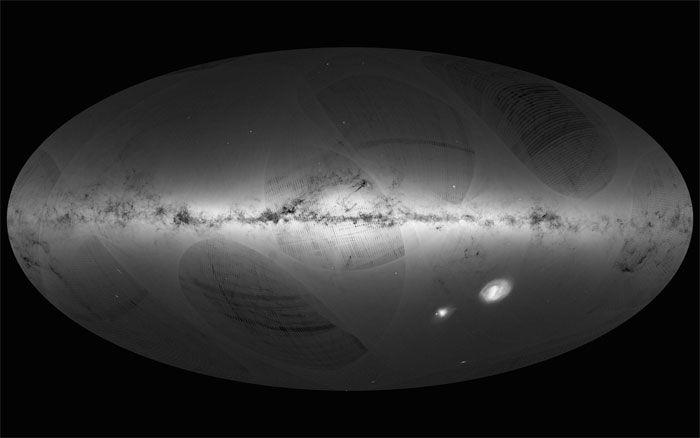The European Space Agency (ESA) has quite recently discharged the most exact and point by point guide of the Milky Way continually, graphing the position in space of more than 1.1 billion stars in our cosmic system.
The 3D map speaks to the principal arrival of information recorded by the ESA's Gaia space observatory, which dispatched in 2013 and started checking the sky in July 2014. In its initial 14 months of operation, it bound the exact position of somewhere in the range of 1,142 million stars.
Alright, with the goal that number is absolutely unfathomable, yet just to give you a feeling of the advancement we're making here, this new astrometry map contains almost 20 times the same number of stars as the past conclusive heavenly index, plotted by the ESA's Hipparcos satellite, which worked somewhere around 1989 and 1993.
Among the 1.142 billion stars that we can now position in space, somewhere in the range of 400 million of them were already obscure to researchers, which implies the Milky Way is a considerably greater spot than we suspected it was.
 |
ESA/Gaia/DPAC |
"The lovely guide we are distributed today demonstrates the thickness of stars measured by Gaia over the whole sky, and affirms that it gathered sublime information amid its first year of operations," says Gaia venture researcher Timo Prusti.
"In spite of the fact that the present information are preparatory, we needed to make them accessible for the cosmic group to use at the earliest opportunity."
Directing the surge of Gaia's crude information on over a billion stars – and guaranteeing that the stellar positions and brightnesses recorded were precise – included the endeavors of around 450 European researchers and programming engineers.
And all that exertion doesn't simply educate us regarding the position in space of these 1.142 billion stars. By contrasting Gaia's perceptions and the information from two past star maps – the Hipparcos and Tycho–2 lists – the researchers could gauge separations and movements for around 2 million stars, giving us a remarkable perspective of the physical development of stars through the universe.
The more noteworthy scope of Gaia's telescopes likewise implies we can see further into space than any time in recent memory.
The test – situated around 1.5 million kilometers (932,000 miles) far from Earth – packs a 1 billion-pixel camera, and is equipped for measuring the distance across of a human hair from 1,000 kilometers away.
That extraordinary look is paying off, and implies we can now get stellar groups beforehand avoided view.
"With Hipparcos, we could just dissect the 3D structure and progression of stars in the Hyades, the closest open bunch to the Sun, and measure separations for around 80 groups up to 1,600 light-years from us," says Antonella Vallenari from the Istituto Nazionale di Astrofisica (INAF) in Italy.
"Be that as it may, with Gaia's first information, it is presently conceivable to quantify the separations and movements of stars in around 400 groups up to 4,800 light-years away."
Maybe the most energizing thing about every one of this is Gaia is just barely beginning. Those stripey designs that sort of look like inestimable fingerprints in the guide above are relics from the test's underlying outputs, and will blur in time as extra perceptions are taken.
Gaia's general mission will keep running for a long time, and was initially anticipated that would overview 1 billion stars. The ESA researchers have as of now bested that, clearly – yet despite the fact that plotting 1.142 billion stars is a gigantic accomplishment, we're still just beginning to expose what's underneath, as that figure speaks to just around 1 percent of the conservatively assessed 100 billion stars inside the Milky Way.
While there's no possibility Gaia will have the capacity to review these stars in its 5-year mission time period, the researchers are currently modifying their desires of what number of stars they'll discover, since they've as of now obscured their underlying objective.
"It looks particularly like we belittled the quantity of stars," one of the scientists, Floor van Leeuwen from the University of Cambridge in the UK, told the press this week. "We think we will see 2–2.5 billion stars."
It's a major new target, however given what amount the ESA has as of now accomplished with this test, why should we question them? One thing's without a doubt: our comprehension of the cosmic system we're a part of is expanding at a quick rate, and for science and space significant others, it's an energizing time.
"Gaia is at the cutting edge of astrometry, diagramming the sky at precisions that have never been accomplished," says the ESA's Director of Science, Alvaro Giménez.
"Today's discharge gives us an initial introduction of the remarkable information that anticipate us and that will alter our comprehension of how stars are appropriated and move over our cosmic system."
Fifteen studies in light of the Gaia examination will be distributed in an up and coming unique release of Astronomy and Astrophysics

Comments
Post a Comment